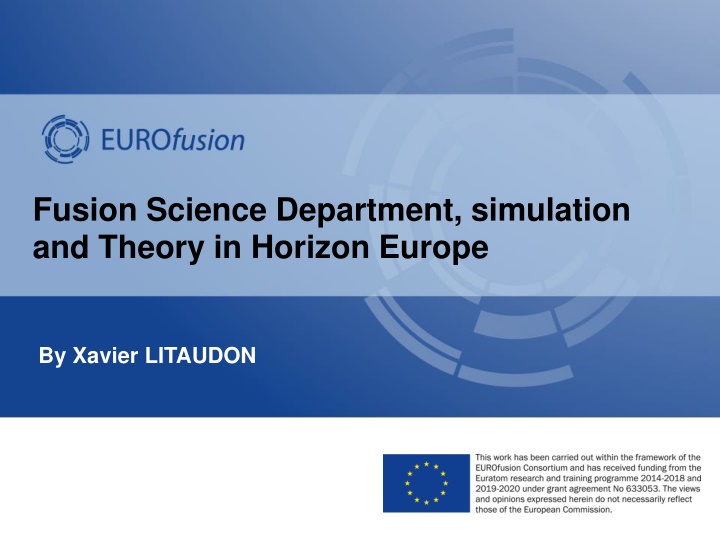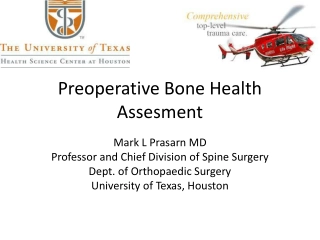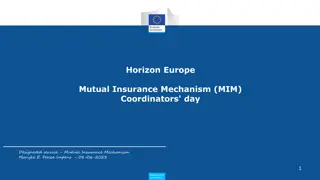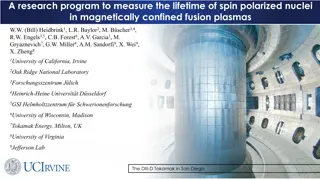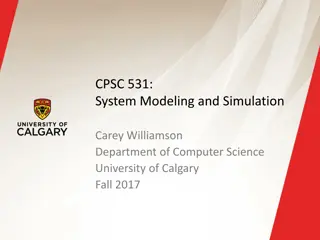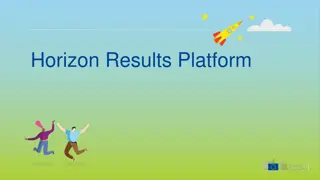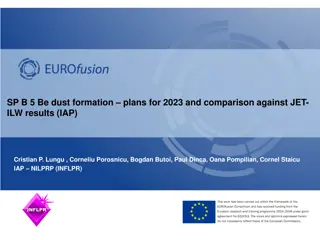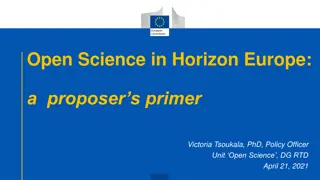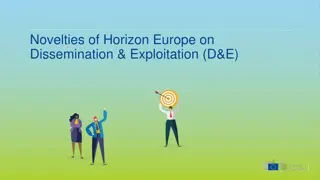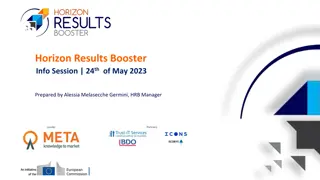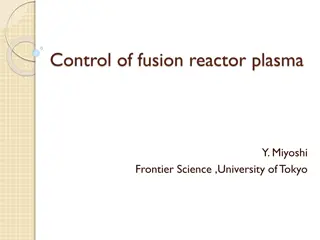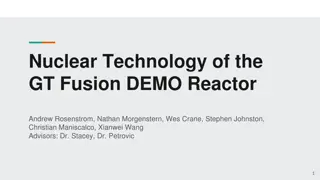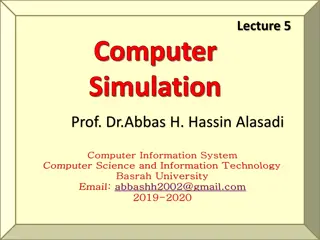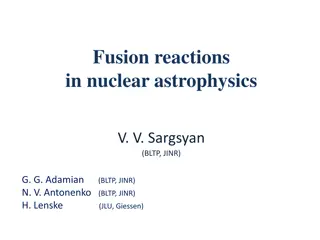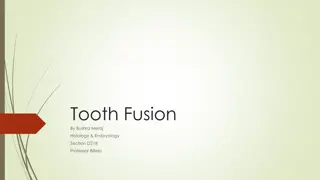Fusion Science Department, simulation and Theory in Horizon Europe
Major objectives of the Fusion Science Department in Horizon Europe encompass strengthening operational aspects, enhancing modelling capability, maximizing EU return on investment in ITER, developing alternative exhaust solutions for DEMO, and exploring the potential of stellarator technology. The focus is on advancing physics studies, achieving disruption-free scenarios, and preparing for future phases beyond ITER operation. Collaboration with EU Fusion Labs and the implementation of innovative control strategies are pivotal for success.
Download Presentation

Please find below an Image/Link to download the presentation.
The content on the website is provided AS IS for your information and personal use only. It may not be sold, licensed, or shared on other websites without obtaining consent from the author.If you encounter any issues during the download, it is possible that the publisher has removed the file from their server.
You are allowed to download the files provided on this website for personal or commercial use, subject to the condition that they are used lawfully. All files are the property of their respective owners.
The content on the website is provided AS IS for your information and personal use only. It may not be sold, licensed, or shared on other websites without obtaining consent from the author.
E N D
Presentation Transcript
Fusion Science Department, simulation and Theory in Horizon Europe By Xavier LITAUDON
Fusion Science Department: Major objectives during Horizon Europe From ITER Design, Construction to Operation As a consequence the programme will strengthen Operational aspects: control for Disruption, Power flux on PFC using MST, JET and JT-60SA including nuclear aspects (DT at JET) Modelling capability: preparation of operation and extrapolation to ITER /DEMO Maximise EU return for the large EU investment into ITER ITER scenario to be significantly developed for DEMO and FPPs integrated approach for the physics studies for ITER and DEMO (similar tools) focus on aspects beyond ITER (no ELMs, disruption free, radiative scenarios, high beta): benefit ITER phase of operation beyond Q=10 Develop an alternative to conventional exhaust as risk mitigation for DEMO Optimise DEMO schedule once ITER objective fulfilled in the first phase of operation stellarator as an alternative approach to address tokamak challenges disruptions and steady state operation FP9 a decisive period for stellarator M8 X. Litaudon et al.| Interaction with EU Fusion Labs on FP9 | 2
Fusion Science Department: High level Objectives in Horizon Europe Prepare ITER operation with experiments and simulation Solve tokamak limits and improved control disruption, ELMs, Exhaust & PFC, long pulse operation Physics basis for burning plasma Consolidate DEMO physics basis with experiments and simulation ELM-free scenarios and divertor compatibility Integrated real time control under DEMO constrains (disruption free scenario, highly radiating plasmas, detachement control ) PFC qualification under high fluence Implement an alternative path to conventional exhaust for DEMO Lay down the physics and engineering basis for stellarator as an alternative approach for DEMO X. Litaudon et al.| WPCD | ENEA Frascati 25 Feb 2020 | 3
Fusion Science Department: High level deliverables in Horizon Europe EU team with experience on JT-60SA operation and return of experience for efficient EU participation in ITER EU strategy and plans for ITER operation Control strategy to handle disruptions, transient and heat exhaust ITER radiative scenarios with metallic wall in D-D & D-T plasmas Validated simulation tools for ITER and DEMO design DEMO Integrated conceptual design and validated scenarios Select alternative divertor concept & Design DTT prototype divertor Long pulse operation with actively cooled divertor (W7-X, WEST) X. Litaudon et al.| WPCD | ENEA Frascati 25 Feb 2020 | 4
Fusion Science Department: Proposed Modifications of the present implementation New name / grouping Tokamak and Stellarator Exploitation, Theory, Simulation, Verification & Validation (TSVV) Tokamak Exploitation & TSVV Old name / grouping Comments JET1, MST1, MST2, WEST SA Collegium of TFLs SA (JT-60SA Exploitation & TSVV) Since this is differently organised at present (via F4E) for the time being a separate work package is proposed, but in the future this may merge with Tokamak Exploitation Part of S2 activity included in the S1/TSVV tasks under E- TASC and the other part under SPPS E-TASC Scientific Board also responsible for the selection of ENR proposals in this category CD, HLST, CPT and stellarator theory will be absorbed in this; the activities towards IMAS should be properly embedded in the Advanced Computing Hubs Bureau-like Project Board (10 persons) W7X (W7-X Exploitation & TSVV) S1, part of S2 Theory & Simulation Theory & Simulation E-TASC CD, ISA, HLST, CPT Advanced Computing (AC) Plasma Wall Interaction and Exhaust Plasma Wall Interaction and Exhaust (PWIE) & TSVV Support of the ITER Research Plan PFC, JET2 and ADC - Physics EUROfusion needs to be in the NBTF Steering and Advisory Committees no separate Project Board New WP in FP9 Support of the ITER Research Plan (SIRP) & TSVV ITER simulation (CD), JET3, NBTF, ITPA Tony Donn | General Assembly| Ljubljana | 17-18 October 2019 X. Litaudon et al.| Interaction with EU Fusion Labs on FP9 | 5
General principles- Theory and Simulation programme Innovative theory and simulation research is performed when driven by the scientists and engineers themselves Nevertheless, the production of a new portfolio EUROfusion standard software requires a more directed approach To accommodate both, two inter-linked structures: (1) Theory-Simulation-Verification-Validation Tasks within the relevant WPs; (2) Advanced Computing Hubs (~ 5) which provide computer science, scientific computing, data management, code integration, and/or software engineering support for the TSVVs and the entire EUROfusion theory/simulation program develop a new portfolio of EUROfusion standard software. Preparation in 2019-2020 and to prepare next Horizon Europe E-TASC scientific board Pilot TSVV tasks launched in 2019 and new tasks in May 2020 Call for Hosting Advanced Computing Hubs in 2020 X. Litaudon et al.| WPCD | ENEA Frascati 25 Feb 2020 | 6
Theory and Simulation programme : Challenges to be addressed in Horizon Europe for ITER and DEMO Validated predictive capability of the L-H transition and pedestal physics in ITER and DEMO (including ELMs, control and avoidance) Validated predictive capability for heat exhaust in ITER and DEMO (conventional/alternative divertor configurations) Integrated modelling of plasma-wall interactions in ITER & DEMO (incl. HELIAS) Integrated modelling of disruptions in ITER & DEMO (incl. their prediction, mitigation, and avoidance) Integrated modelling of burning plasmas in ITER & DEMO (incl. HELIAS) Validated framework for the reliable prediction of plasma performance and operational limits, including stellarator performance limitations Materials modelling in support to ITER, DONES and DEMO Multi-fidelity system code for DEMO [E-TASC GA report Dec. 2018 & Report by TAG sub-group Assessment of PPP&T DEMO modelling needs 2020] X. Litaudon et al.| WPCD | ENEA Frascati 25 Feb 2020 | 7
Healthy mix of coordinated de-centralized and centralized efforts in a virtuous cycle E-TASC Scientific Board M2, M8 Pedestal-SOL, exhaust, PWI M3 M1, M8 Core- pedestal Materials, neutronics M4-M7 Engineering TSVV Tasks Code integration, integrated modelling, and control (IMAS ) Advanced Computing Hubs Code HPC & mid-range facilities development and deployment on HPC platforms Data analysis (incl. AI) and management EUROfusion standard codes for ITER operation and DEMO design Validated models for ITER & DEMO X. Litaudon et al.| WPCD | ENEA Frascati 25 Feb 2020 | 8
Six ACHs including the JET data center Optimised codes for HPC: scalable algorithms, code parallelization & performance optimization, code refactoring, GPU-enabling etc. Integrated Modelling and Control: code adaptation to IMAS, IMAS framework development etc. EUROfusion data including the JET data: data access, data management, data analysis tools, aspects of AI and VVUQ etc. The Technical University of Denmark (DTU) will be in charge of the JET Data Centre that will host all JET data X. Litaudon et al.| WPCD | ENEA Frascati 25 Feb 2020 | 9
Integrated modelling and control activity within the ACH Provide integration of modules in the IMAS workflows as they get used for Tokamak modelling and take into account changes in the Data Dictionary and computational environments Develop and maintain tools for mapping of experimental data porting of codes in IMAS, and providing Kepler and Python actors, Integration of Kepler and Python actors in IMAS workflows including the European Transport Solver, the EQSTABIL, fast-ions, core-edge and synthetic diagnostics, Provide training and support to EUROfusion users of IMAS and workflows for their validation on JET, MST, JT-60SA data and extrapolation towards ITER/DEMO Provide users support for the exploitation of the EUROfusion workflows via dedicated Technical Responsible Officers Develop new workflows X. Litaudon et al.| WPCD | ENEA Frascati 25 Feb 2020 | 10
JET data center- Structure X. Litaudon et al.| WPCD | ENEA Frascati 25 Feb 2020 | 11
Preparation of ITER operation To develop the EUROfusion ITER data analysis tools within IMAS for the first phase of ITER operation and design ITER operational scenarios through modelling activities using tools validated on EUROfusion experimental facilities; To provide direct inputs and contribution to the ITER research plan; To contribute to the activities of the ITER Neutral Beam Test Facility (NBTF) installed at Padova; To improve our knowledge on nuclear technology and safety issues relevant to ITER and DEMO, to validate nuclear codes and to reduce the risks of ITER operations and maintenance activities by taking advantage of JET DT operation X. Litaudon et al.| WPCD | ENEA Frascati 25 Feb 2020 | 12
Preparation of ITER operation Exploitation of ETS, and the various IMAS workflows in support of the ITER Research Plan in collaboration with ITER- IO Simulation and Theory group and international community Develop ITER data analysis tools including breakdown simulation tool and synthetic diagnostic for the initial plasma operation Design operational scenario for ITER from breakdown to termination while respecting the plan limits (e.g. PF circuits) with free boundary equilibrium and realistic transport, inclusion of validated sources for heating & current drive, fuelling. The activity will include development of tools to enable pre-pulse validation on ITER The development of theory and computational tools will be coordinated by the E-TASC scientific board and specific TSVV tasks are embedded within the WP. X. Litaudon et al.| WPCD | ENEA Frascati 25 Feb 2020 | 13
Conclusion FP-9 preparation with the full roadmap implementation strong theory and modelling programme is essential because empirically-based predictions are uncertain in unexplored environments like ITER and particularly DEMO, and this will be a stronger focus than foreseen earlier Set-up a new initiative within E-TASC to strengthen the theory and simulation programme: Advanced Computing Hubs, and JET data center TSVV Your inputs are extremely valuable to prepare this transition I wish you a successful meeting X. Litaudon et al.| WPCD | ENEA Frascati 25 Feb 2020 | 14
